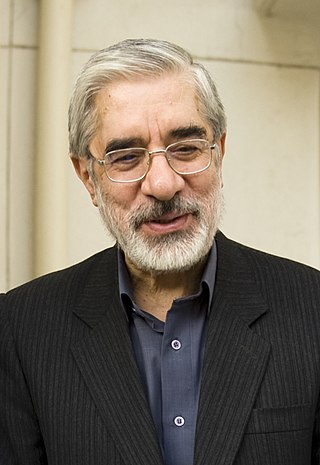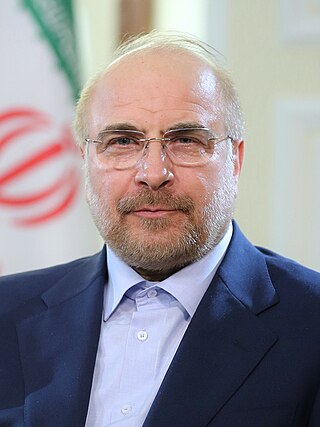
Sayyed Abol-Ghasem Mostafavi-Kashani was an Iranian politician and Shia Marja.He played an important role in the 1953 coup in Iran and the overthrow of Prime Minister Mohammad Mosaddegh.

Mohammad Hosseini Beheshti was an Iranian jurist, philosopher, cleric and politician who was known as the second person in the political hierarchy of Iran after the Revolution. Beheshti is considered to have been the primary architect of Iran's post-revolution constitution, as well as the administrative structure of the Islamic republic. Beheshti is also known to have selected and trained several prominent politicians in the Islamic Republic, such as former presidents Hassan Rouhani and Mohammad Khatami, Ali Akbar Velayati, Mohammad Javad Larijani, Ali Fallahian, and Mostafa Pourmohammadi. Beheshti also served as the Secretary General of the Islamic Republic Party, and was the head of the Iranian judicial system. He further served as Chairman of the Council of Islamic Revolution, and the Assembly of Experts. Beheshti earned a PhD in philosophy, and was fluent in English, German and Arabic.

Akbar Hashemi Rafsanjani was an Iranian politician, writer, and one of the founding fathers of the Islamic Republic who was the fourth president of Iran from 1989 to 1997. He was the head of the Assembly of Experts from 2007 until 2011 when he decided not to nominate himself for the post. He was also the chairman of the Expediency Discernment Council.

Mohammad-Ali Rajai was the second president of Iran from 2 to 30 August 1981 after serving as prime minister under Abolhassan Banisadr. He was also minister of foreign affairs from 11 March 1981 to 15 August 1981, while he was prime minister. He was assassinated in a bombing on 30 August 1981 along with prime minister Mohammad-Javad Bahonar.

Mir-Hossein Mousavi Khameneh is an Iranian reformist politician, artist and architect who served as the 49th and last Prime Minister of Iran from 1981 to 1989. He was a reformist candidate for the 2009 presidential election and eventually the leader of the opposition in the post-election unrest. Mousavi served as the president of the Iranian Academy of Arts until 2009, when conservative authorities removed him. Although Mousavi had always considered himself a reformist and believed in promoting change within the 1979 Revolution constitution, on 3 Feb 2023, in response to the violent suppression of Iranians by Ali Khamenei, the Supreme Leader of Iran, he announced opposition to the Islamic Republic constitution and asked for a widespread referendum to fully change the constitution and make a fundamental change in Iran's political system.

Mohammad Reza Aref is an Iranian engineer, academic and reformist politician who was the parliamentary leader of reformists' Hope fraction in the Iranian Parliament, representing Tehran, Rey, Shemiranat and Eslamshahr. Aref has also been heading the Reformists' Supreme Council for Policymaking since its establishment in 2015.He is currently member of the Expediency Discernment Council.

Ali Akbar Velayati is an Iranian conservative politician and physician. He is currently a member of the Expediency Discernment Council. Velayati is a distinguished professor at Shahid Beheshti University of Medical Sciences, senior adviser to the Supreme Leader in international affairs and head of the board of founders and the board of trustees of the Islamic Azad University.

Mohammad Bagher Ghalibaf or Mohammad Baqer Qalibaf is an Iranian conservative politician, former military officer, and current Speaker of the Parliament of Iran since 2020. He held office as the Mayor of Tehran from 2005 to 2017. Ghalibaf was formerly Iran's Chief of police from 2000 to 2005 and commander of the Revolutionary Guards' Air Force from 1997 to 2000.

Presidential elections were held in Iran on 8 June 2001, and resulted in Mohammad Khatami being elected as the President of Iran for his second term.

Presidential elections were held in Iran on 16 August 1985, and resulted in the re-election of the incumbent President Ali Khamenei.
Presidential elections were held in Iran on 24 July 1981 after the previous Iranian president, Abolhassan Banisadr, was impeached by the Majlis on 21 June and then sacked by the Supreme Leader, Ayatollah Khomeini, on 22 June. The elections occurred after the Hafte Tir bombing, which killed Mohammad Beheshti and dozens of other Iranian officials on 28 June 1981. This led to the election of Mohammad Ali Rajai, the previous prime minister, winning 13,001,761 votes out of the 14,573,803 votes cast, which was 89% of the votes. The vote turnout was 65.29%.

The Islamic Republican Party was formed in 1979 to assist the Iranian Revolution and Ayatollah Khomeini in their goal to establish theocracy in Iran. It was disbanded in 1987 due to internal conflicts.

Ali Akbar Nateq-Nouri is an Iranian politician, who served as the Chairman of the Parliament of Iran from 1992 to 2000. He was also the Minister of the Interior of Iran from 1981 to 1985.

On 28 June 1981, a powerful bomb went off at the headquarters of the Islamic Republican Party (IRP) in Tehran, while a meeting of party leaders was in progress. Seventy-four leading officials of the Islamic Republic of Iran were killed, including Chief Justice Ayatollah Mohammad Beheshti, who was the second most powerful figure in the Iranian Revolution. The Iranian government first blamed SAVAK and the Iraqi regime. Two days later, on 30 June, the People's Mujahedin of Iran was accused by Khomeini of being behind the attack. Several non-Iranian sources also believe the bombing was conducted by the People's Mujahedin of Iran.

Moderation and Development Party is a political party in Iran. It is a pragmatic-centrist political party which held its first congress in 2002.

The parliamentary election for the 9th Islamic Consultative Assembly, or Majlis, were held in Iran on Friday, 2 March 2012 with a second round on 4 May 2012 in those 65 districts where no candidate received 25% or more of the votes cast. More than 5,000 candidates registered but more than a third were disqualified by the Guardian Council leaving about 3,400 candidates to run for the 290 seat representing the 31 provinces.
The following lists events that happened during 1981 in Iran.

The office of Mohammad Javad Bahonar, Prime Minister of Iran, was bombed on 30 August 1981 by the People's Mujahedin of Iran (MEK), killing Bahonar, President Mohammad Ali Rajai, and six other Iranian government officials. The briefcase bombing came two months after the Hafte Tir bombing, which killed over seventy senior Iranian officials, including Chief Justice Mohammad Beheshti, then Iran's second-highest official.















